One Hour in Chiang Mai: A Street Photographer's Sprint
- Tatiana Mocchetti
- Jul 4
- 6 min read
What can you capture in just one hour? If you're in Chiang Mai, the answer is: everything that matters. As street photographers, we often fantasize about endless golden hours and slow, wandering days. But the reality is different. Sometimes, we have only sixty minutes—between errands, family plans, or fading light. The challenge is not just artistic; it's logistical, intuitive, and deeply personal. Chiang Mai, with its mix of raw beauty and everyday hustle, becomes the perfect arena for a time-constrained shoot.
This blog post dives into how to make the most of that single hour. Through the lens of my recent sprint in Ban Tawai—a village just outside Chiang Mai known for its craftsmen—I’ll walk you through how I approached, adapted, and captured honest, human work within a ticking clock.
Why One Hour in Chiang Mai Can Still Deliver Gold
Chiang Mai is compact, rich in texture, and emotionally open. It offers you frames at every corner: weathered hands, flickering lanterns, layered fabrics, bicycles passing banyan trees. Even with time against you, you don’t need to look far to find a story worth telling.
What makes a one-hour shoot so powerful is the urgency—it strips away overthinking and forces instinct to take over. It also challenges your ability to see fast, connect instantly, and shoot with purpose.
Choose Your Arena: Why I Picked Ban Tawai
When you have only one hour, you need to commit. I chose Ban Tawai, not just because it's rich with character, but also because it's close to home—only a few minutes’ drive from where I live. Convenience matters when you're chasing light and only have sixty minutes to make it count.
Ban Tawai is a village synonymous with woodworking and furniture making. It’s not on most tourist maps, but it holds an enormous amount of life: chisels against teak, sawdust in the air, sparks from welding masks, and lacquer fumes swirling like smoke.
It offered what I needed: strong light and shadow, human presence, and the poetry of repetition. No performances—just people working, unaware or unconcerned with the camera. I chose Ban Tawai, a village synonymous with woodworking and furniture making. It’s not on most tourist maps, but it holds an enormous amount of life: chisels against teak, sawdust in the air, sparks from welding masks, and lacquer fumes swirling like smoke.
Ban Tawai offered what I needed: strong light and shadow, human presence, and the poetry of repetition. No performances—just people working, unaware or unconcerned with the camera.
My Setup: What I Carried
For this shoot, I kept it simple but versatile. I used my beloved Canon 90D, a camera I trust deeply for its balance of speed, clarity, and durability. I paired it with two lenses: I brought two lenses:
Canon 85mm f/1.8 – perfect for tight portraits and compressing chaotic backgrounds.
Canon 18–135mm kit lens – flexible enough to switch between wide context and spontaneous close-ups.
The 85mm gave me intimacy; the 18–135 let me adapt quickly to changing distances without needing to move too much.
Scan & Anchor
As soon as I stepped into the workshop zone, I gave myself five minutes to breathe. I walked slowly, camera ready but low. I wanted to feel the rhythm—not just of the place, but of the people. The way they moved, the sounds of metal against wood, the light peeking through metal roofs. That first impression set the tone.
In those first fifteen minutes, I:
Located three active sites: one wood sorting area, one carving zone, and one welding station.
Chose my anchor: a man surrounded by wood blocks, his face masked, his hands moving deliberately.
I shoot on aperture priority mode. I just play with the aperture and let the camera do the rest—shutter speed and ISO included. It’s how I stay in the moment, reacting without overthinking.
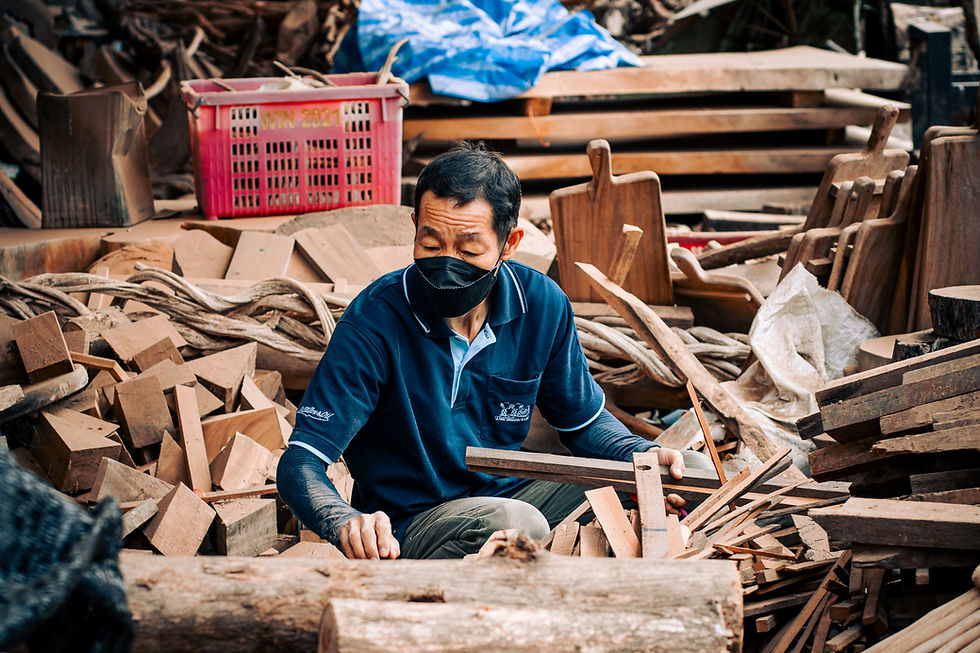
Commit & Observe
I stayed with my anchor subject. He was sorting and shaping wooden pieces, and though we didn’t exchange words, our silence worked. There was a mutual respect in that moment—he kept working, I kept shooting. I framed him low and tight—letting the chaos of wood around him tell the story, not just his expression.
Then I shifted—just ten steps away, a man in a wide-brimmed hat was carving handles with a chisel. His pace was calm, his focus deep. Each gesture was methodical, spiritual even. He wasn’t rushing. That helped me slow down too, even in this one-hour sprint.
Layers, Sparks, and Color
Time was pressing. I moved quickly to a nearby shed where a woman in an orange hat was assembling stools. The symmetry of her work—round tops stacked in threes—offered pattern and repetition. These details can turn an ordinary shot into something meditative. I crouched low to capture her face partially hidden behind safety gear, hands in action, surrounded by lines of form and function.
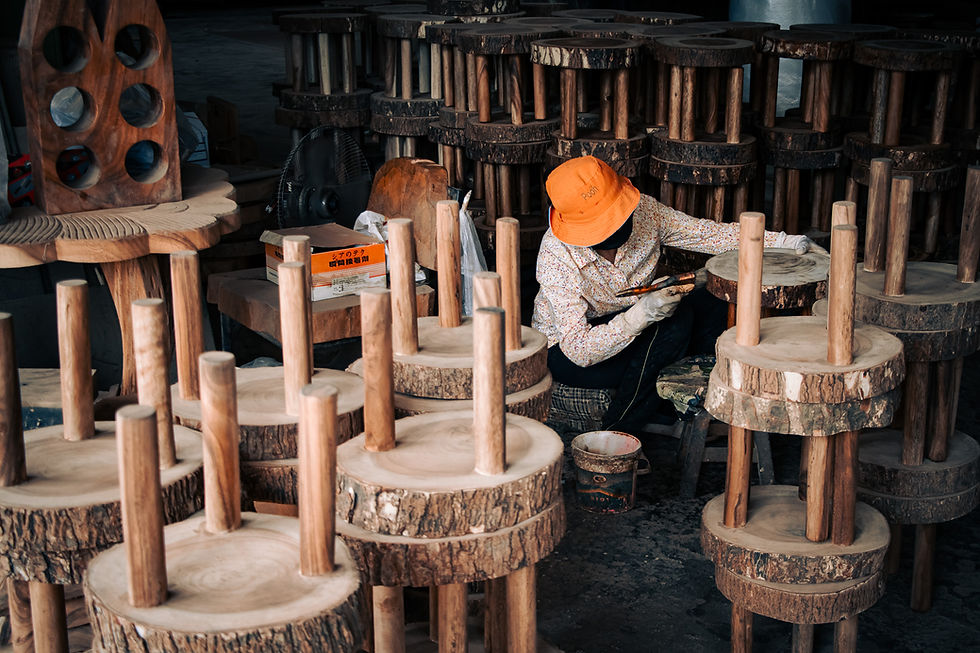
Then I heard it: the electric snap of welding. Around the corner, a welder. Sparks flying. The moment I saw him, I knew it was my hero shot. The arcs of light, the reflections in his mask—it felt like something out of a dream. I waited for the right burst, then exposed slightly under to preserve the glow. Two frames later, I had what I came for.
The Unexpected Shot
With barely 15 minutes left, I stumbled into a mist-filled room. A woman was spraying lacquer on wide teak panels. The light streamed in from the side, hitting the mist just right. It looked like smoke in a temple—soft, sacred, floating.
I had no tripod, no time to ask for permission. I adjusted quickly: ISO 160, f/2.5, and shutter speed at 1/125. It was a scene that required intuition, not preparation. Three clicks. That’s all. And then the moment was gone, like breath disappearing in sunlight.
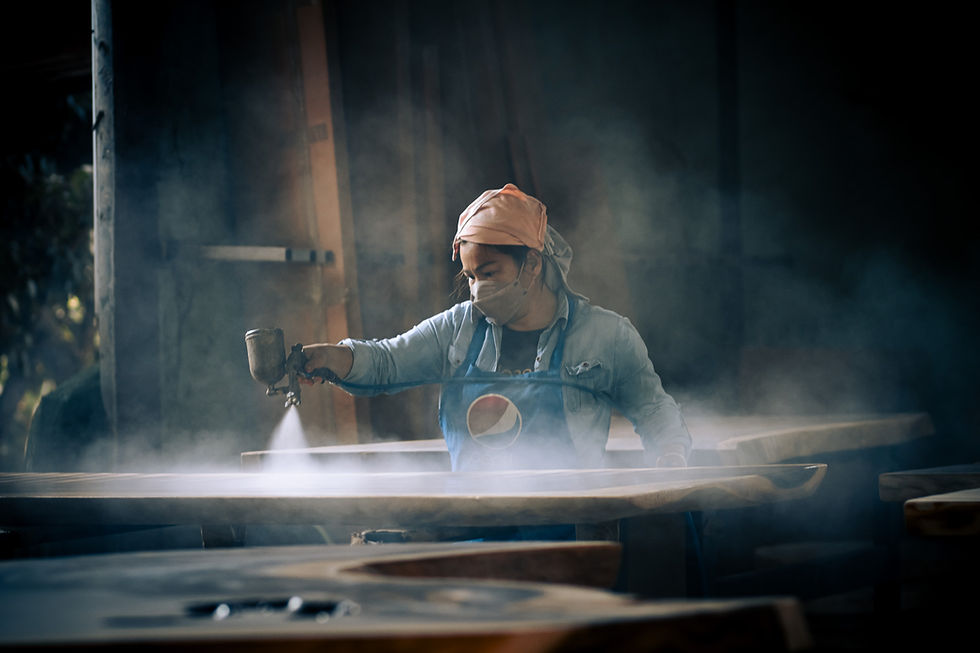
Ban Tawai in 60 Minutes: Craft in Motion
I
mages from the shoot:
"Sorting through the language of wood" – A masked man sifting through hardwood blocks.
"Shaping raw limbs into purpose" – A craftsman carving slowly, eyes narrowed, chisel steady.
"Precision made from memory" – A woman fitting stools together in perfect rhythm.
"Sparks and symmetry" – A welder mid-process, arcs lighting up his mask like theatre.
"Where sparks become sculpture" – A closer, moodier frame of the same welder, face almost robotic.
"The poetry of repetition" – Lacquer floating in the air like incense as a woman sprays silently.
Each image was taken under pressure—and that pressure became part of the story.
And What If Nothing Comes Out of the Shoot?
Let’s be honest. Sometimes, you give it your all—and nothing clicks. Maybe the light’s flat. Maybe people are guarded. Maybe you’re just not feeling it. And that’s okay.
Street photography isn’t about scoring every time. It’s about showing up. Even when the images don’t come, the habit of observing, noticing, and being present adds value.
Sometimes, those “failed” sessions are where we refine our instincts the most. The next time you shoot, your reactions will be sharper. Your eye, quicker. Your soul, more open.
So if nothing comes out of it, take a deep breath. You were there. That counts.
Quick Takeaways
One hour is enough if you slow down your mind and speed up your instincts.
Choose one place, one visual theme, and stay committed.
Great light often comes where you least expect it—be ready.
Always respect the rhythm of the people you photograph.
Don’t overshoot—aim for 50 intentional frames, not 300 random ones.
And if nothing comes out of the shoot? You still grew as a photographer.
Conclusion
Time is not your enemy—it’s your muse. When you're given just one hour, every frame matters more. You stop worrying about perfection and start chasing presence.
In Ban Tawai, I found more than just images. I found rhythm, labor, repetition, and poetry—hidden in wood shavings and welding sparks. The artisans didn’t pose. They just did what they do best: work with care, concentration, and pride.
So next time you have just an hour, don’t scroll. Don’t wait. Pick a spot. Raise your camera. And trust that the story is already happening.



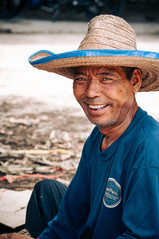










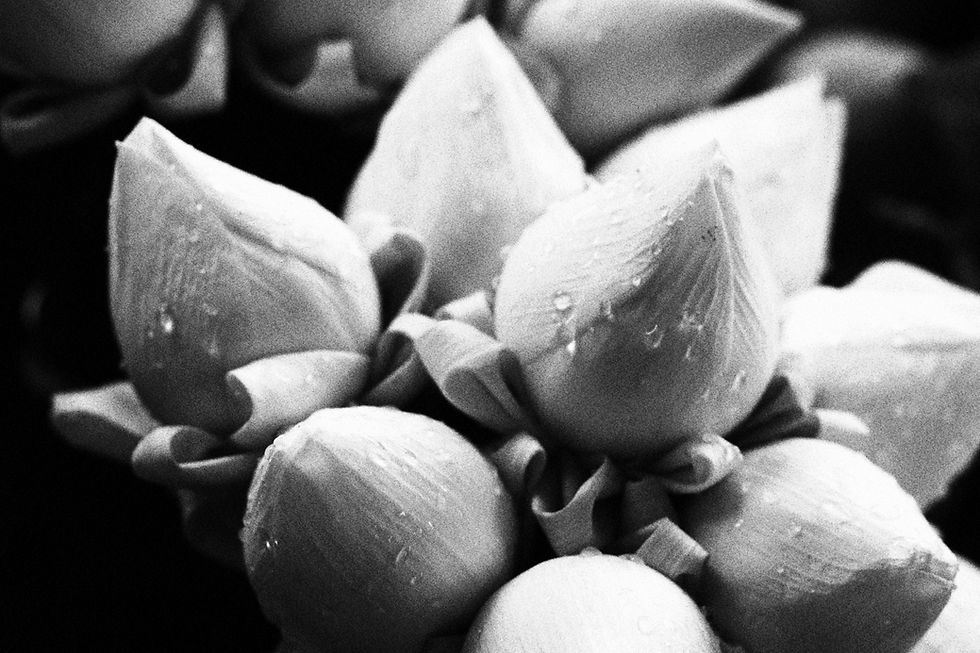


Comments